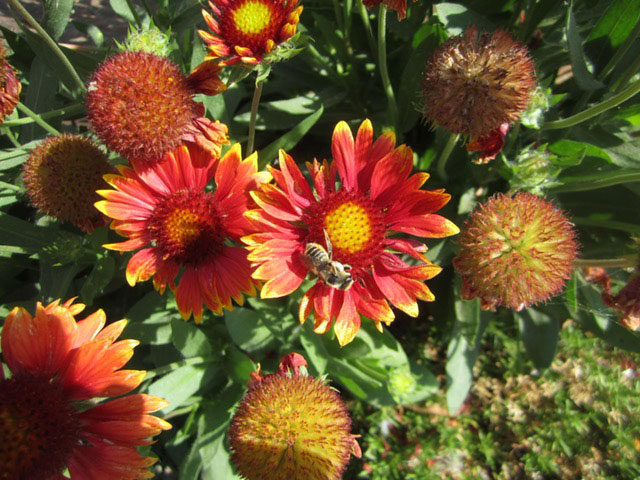How world economics is in the hands of pollinating agents
Natural or biological pollinating agents like insects (such as bees, moths, butterflies, some species of beetles and flies), mollusks (some species of snails and slugs), birds (humming birds) and mammals (bats) play an important role in transferring pollens from anther (or the male reproductive part) of the flower of a higher plant (angiosperm) to stigma (or female reproductive part) of the flower; for the purpose of achieving sexual reproduction and for the successful transmission of heritable traits and genetic characteristics. Without the natural or biological pollinators a wide diversity flowering plants will fail in achieving natural cross pollination; and that will directly impact their reproduction, fruit and seed productions, genetic qualities and various yield parameters. It is important to mention that a large number of our food, forage and industrial crops, vegetables, ornaments plants, fruit trees and forest tree species are naturally cross pollinated. Hence, loss or crash in the natural populations of biological pollinators can significantly impact agricultural yield and global food security. Among all the natural and biological pollinators; the pollinator insects are facing an alarming decline of their populations; and the worst impacted being the different honey bee species as well as native or indigenous bee species due to a number of important factors. Among some of the very important natural and human induced factors are rapid rise of human populations, loss of virgin forests, rapid growth and development of agriculture and industry, environmental pollution, excessive and unrestricted use of different agricultural chemicals in the crop fields, change in the land use patterns,
different parasitic diseases of the bees, colony collapse disorder, lack of suitable plants or crops for bee foraging and bee nutrition to mention only a handful.
Loss of bees not only signifies destabilization and degradation of our natural ecosystems; but also significant financial loss and possible economic hardships due to its direct impact on agriculture (crop production), forestry (ecosystem degradation) and apiculture (bee keeping). Bees have been associated with human civilizations from time immemorial due to honey and natural bee wax production by honey bees. But not just
honey bees; other non-honey producing native or indigenous bees across the planet perform monumental ecological services in successfully achieving cross pollination in large number of wild plants and crops. Hence there is an urgent need for conserving the vulnerable honey bees and native bee species around the planet for their dual role in maintaining the harmony of ecosystem and economics. It is therefore important to develop sustainable, long term, eco-friendly approaches to facilitate successful bee conservation. Some of the important steps towards successful bee
conservation is restricting and reducing the use of excessive, indiscriminate, unmonitored or under monitored over application of agricultural chemicals on the crops in the agricultural fields. This excessive application of toxic chemicals to secure high yield and protect crops against various insect pests is also targeting friendly insect pollinators like bees; wiping them out in large numbers. Hence it is important for crop producers and farmers to realize that they need to be more environmentally sensitive and responsible in protecting the natural environment while applying agricultural chemicals. Encouraging chemical free ‘organic agriculture’ is another viable alternative to reduce chemical induced agricultural pollution; and thus help in protecting bees and other insect pollinators. Suitable crop rotations and fallows can also facilitate in reducing pollution and helping towards bee conservation. Another alternative approach could be establishing Bee Gardens or Bee Habitats or Bee Sanctuaries buy using suitable Pollinator Mixes comprising of native flower species as well as pollinator friendly annual, biennial and perennial forage crop species. Some grasses could also be included in the mix for the creation of natural or artificial habitats
around forest fringe areas, perimeters of industrial and agricultural production sites, wasteland (agronomically unsuitable/inaccessible areas) and wetland habitats (ponds, pools, bogs, swamps, ditches, lakes, streams, rivulets, irrigation canals). Pollinator Sanctuaries can be designed in city parks and gardens; as well as home gardens or home lawns or backyard kitchen gardens too to encourage bees foraging and visiting artificial and/or natural habitats to collect pollens and nectar. City or town boulevards, avenues, ditches along highways and freeways all could be successfully targeted for developing natural and/or artificial Bee Habitats or Bee Sanctuaries. In short any free or unused available space in urban or rural areas could be utilized for developing such low cost and low maintenance Bee Sanctuaries in different agro-climatic regions to facilitate the successful conservation of honey bees, native and indigenous bees as well as other important insect pollinators like moths and butterflies and some pollination friendly species of beetles and flies. Education and awareness has an important role to play in bringing all stakeholders to a common platform to join hands in successful bee conservation like crop producers, farmers, apiculturists, professional pollinators, agrologists, environmentalists, agriculturists, ecologists, foresters, chemists, nursery and greenhouse operators, agricultural product companies, government and non-government agencies. We need to realize that everyone needs to work hand in hand to face this global crisis of dwindling numbers of bee due to severe crash in their natural populations. Together we can make a positive change in helping to conserve the bees and other insect pollinators. We need to start right now!
*Proper wildlife rehabilitation is an extremely biologically and ecologically responsible attitude toward all living things.*

